Archived - Gender Equality Statement
The Canadian story is one where all people, from all backgrounds, come together for a common good. When everyone can contribute their perspective, skills and insights to the social and economic progress of Canada, the country is enriched. Those shared values of cooperation, fairness and respect for all persons underpin the Government’s commitment to greater equality in Canada. When every Canadian has the opportunity to succeed, all Canadians benefit.
Advancing Gender Equality and Diversity
Key GBA+ Milestones
- Canada's first gender-balanced Cabinet
- First full Minister for Status of Women appointed
- GBA+ becomes mandatory for all Memoranda to Cabinet and Treasury Board submissions
- Canada's first ever Gender Statement published
- Budget 2018 establishes Canada's Gender Results Framework
- Parliament passes the Canadian Gender Budgeting Act
- Department for Women and Gender Equality is created
Gender budgeting is a foundational element of the Government’s strategy to improve equality in Canada. Although the Government has been using Gender-based Analysis Plus (GBA+) in the development of policies and programs for over two decades, it has prioritized and reinvigorated this commitment in recent years. Changes put in place by the Government since 2015 are designed to ensure an ongoing focus on gender equality. The Government will continue to strive to improve the quality of data that informs GBA+ across departments.
The Canadian Gender Budgeting Act was passed by Parliament in December 2018, enshrining the Government’s commitment to decision-making that takes into consideration the impacts of policies on all Canadians in a budgetary context.
The Department for Women and Gender Equality was also established through legislation introduced by the Government. The new department will advance equality for all Canadians across many dimensions such as sex, sexual orientation, gender identity or expression, race, national and ethnic origin, Indigenous origin or identity, age, socio-economic condition, place of residence and disability. This legislation recognizes the important role that the Minister for Women and Gender Equality plays in providing guidance, best practices and expertise in the area of GBA+.
In Budget 2018, GBA+ was performed for every single budget measure and GBA+ information was included for the main budget measures. Budget 2019 moves even further, reflecting concerted efforts to incorporate GBA+ in the policy development process and to make the Government’s analysis available to Canadians. The first part of this chapter presents information on where we currently stand with regard to equality, and how recent government actions work towards improving disparities. The chapter concludes with an overview of GBA+ impacts of Budget 2019 as a whole, while the Budget 2019 GBA+ Annex contains a comprehensive summary of GBA+ analysis by measure. GBA+ continues to be a work in progress; the Government invites Canadians to share their ideas on what they find valuable in this analysis and how it could be improved in future budgets.
Gender Results Framework
“All countries must step up their efforts to ensure that public policy truly reflects—and results in—more inclusive societies, in which boys, girls, men and women can all reach their true potential.”
The Government’s Gender Results Framework (GRF) was introduced in Budget 2018 as a whole-of-government tool to help guide future policy decisions and to track developments in gender equality and diversity across a number of identified policy priorities. These priorities, which range from addressing the gender wage gap to promoting more equal parenting roles, are associated with a set of goals and indicators to benchmark progress in achieving gender equality and diversity in Canada. Federal, provincial and territorial ministers have also agreed to track a subset of gender equality indicators to measure progress over time. Canadians can learn more about the Gender Results Framework by accessing two new resources:
- On March 19, 2019, to complement the tabling of Budget 2019, the Department for Women and Gender Equality launched the Gender Results Framework Portal, an up-to-date source of data and research relevant to the indicators included in the Framework.
- Statistics Canada launched the Centre for Gender, Diversity and Inclusion Statistics on September 26, 2018. The Centre houses quick facts, statistics and recent analysis related to gender equality and diversity, as well as detailed data tables related to the Gender Results Framework indicators.
This section presents statistics on a number of GRF indicators, summarizing the current status of the indicators today, noting important action that has been taken to advance progress and highlighting areas where further attention is needed. GRF indicators are not expected to change overnight, but this information reflects the Government’s commitment to tracking progress. In other words, the GRF helps the Government see where Canada was, where it is now, and where it can be in relation to gender equality.
Note: In this section, the term "visible minorities" is used because it is the official demographic category defined by the Employment Equity Act and used by Statistics Canada, which facilitates longitudinal comparisons.
Minister of Finance Leadership at Home and on the International Stage
The International Gender Champions initiative was launched at the Palais des Nations in Geneva in 2015 as a platform for senior leaders to unite in building a world where gender differences do not prevent individuals from achieving their potential.
In June 2018, the Minister of Finance announced he would become an International Gender Champion, the world’s first national Finance Minister to do so.
In becoming an International Gender Champion, the Minister of Finance made three concrete commitments to advance gender equality:
- To ensure rigorous gender budgeting as a means to achieve greater equality and inclusion.
- To achieve gender parity in Canadian appointments to the board of International Finance Institutions for which the Minister of Finance is governor, and to instruct these appointees to prioritize gender equality in their work at these institutions.
- Pledging to no longer sit on single-sex panels. This pledge is at the core of the International Gender Champion initiative.
Canada’s Gender Results Framework
Canada’s economic future depends on people having equal opportunity to reach their full potential, regardless of gender.
Gender Equality Goals for Canada
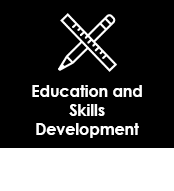
Equal opportunities and diversified paths in education and skills development
- More diversified educational paths and career choices
- Reduced gender gaps in reading and numeracy skills among youth, including Indigenous youth
- Equal lifelong learning opportunities and outcomes for adults
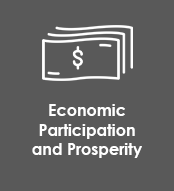
Equal and full participation in the economy
- Increased labour market opportunities for women, especially women in underrepresented groups
- Reduced gender wage gap
- Increased full-time employment of women
- Equal sharing of parenting roles and family responsibilities
- Better gender balance across occupations
- More women in higher-quality jobs, such as permanent and well-paid jobs
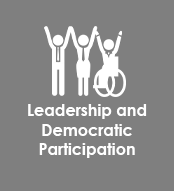
Gender equality in leadership roles and at all levels of decision-making
- More women in senior management positions, and more diversity in senior leadership positions
- Increased opportunities for women to start and grow their businesses, and succeed on a global scale
- More company board seats held by women, and more diversity on company boards
- Greater representation of women and underrepresented groups in elected office and ministerial positions in national and sub-national governments
- Increased representation of women and underrepresented groups as administrators of the justice system
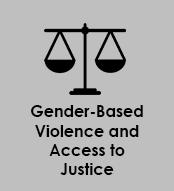
Eliminating gender-based violence and harassment, and promoting security of the person and access to justice
- Workplaces are harassment-free
- Fewer women are victims of intimate partner violence and sexual assault
- Fewer victims of childhood maltreatment
- Fewer women killed by an intimate partner
- Increased police reporting of violent crimes
- Fewer Indigenous women and girls are victims of violence
- Increased accountability and responsiveness of the Canadian criminal justice system
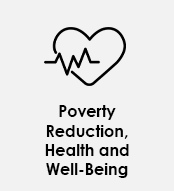
Reduced poverty and improved health outcomes
- Fewer vulnerable individuals living in poverty
- Fewer women and children living in food insecure households
- Fewer vulnerable individuals lacking stable, safe and permanent housing
- Child and spousal support orders are enforced
- More years in good health
- Improved mental health
- Improved access to contraception for young people and reduced adolescent birth rate
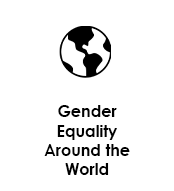
Promoting gender equality to build a more peaceful, inclusive, rules-based and prosperous world
- Feminist international approach to all policies and programs, including diplomacy, trade, security and development
The GRF is aligned with the Government of Canada’s policy of GBA+, ensuring that gender is considered in relation to other intersecting identity factors. Wherever possible, intersecting identity factors will be considered in the above indicators.
Education and Skills Development
Choices about and access to education should be based on interests, aptitudes and goals, free from gendered expectations and stereotypes. This helps Canadians reach their full potential, fostering equality and stronger economic growth. Looking ahead, technological advancement is changing the types of jobs available and the skills needed to succeed in those roles. Lifelong learning to master new skills is proving increasingly necessary to remain competitive. For these reasons, the Government has taken steps to make it easier for Canadians to get the skills training they need and to promote more gender equality in educational outcomes, and help boost the economy.
Key Gender Results Indicators: Where We Stand
Goal: More diversified educational paths and career choices
- Boys are less likely to complete high school than girls. For example, in 2016, 90 per cent of women aged 25-64 years had obtained at least a high school diploma, compared to 87 per cent of men of the same age.
- Women are more likely to continue their education than men, representing 53 per cent of post-secondary credential holders aged 25-64 years in 2016.
- Women with intersecting identities may face additional barriers reaching their educational goals. For example, First Nations, Inuit and Métis women aged 25-64 years have lower high school completion rates than non-Indigenous women at 73 per cent, 57 per cent and 85 per cent, respectively. Indigenous men have even lower rates: 66 per cent among First Nations, 55 per cent among Inuit and 79 per cent among Métis.
- Women are less likely to pursue studies in architecture, engineering, mathematics and computer science than men, accounting for only 24 per cent of students at the undergraduate level in 2016-17. In contrast, men are less likely to study education and health-related fields, accounting for 24 per cent of undergraduate students.
Goal: Reduced gender gaps in reading and numeracy skills among youth, including Indigenous youth
- In 2015, boys aged 15 years had lower average reading scores than girls (514 versus 540), while girls had lower average mathematics scores than boys (511 versus 520). Average science scores were similar across genders (528 for boys and 527 for girls).
- Voluntary questions on Indigenous identity will be included in six provinces as part of the 2018 Programme for International Student Assessment.
Goal: Equal lifelong learning opportunities and outcomes for adults
- Adult women had lower numeracy scores than men in 2012 (258 versus 273), while adult literacy scores were similar across genders (272 versus 275).
- Women and men were equally likely to participate in adult education and training in 2012 (57 per cent versus 58 per cent).
Sources: 2016 Census; Postsecondary Student Information System; OECD Programme for International Student Assessment; C.D. Howe Institute; OECD Programme for the International Assessment of Adult Competencies; 2012 OECD Survey of Adult Skills; Department of Finance Canada calculations.
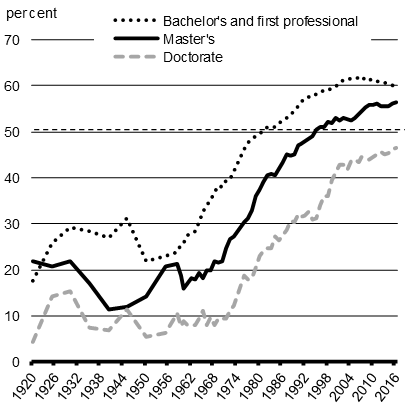
Education improves the likelihood of finding a high-quality job and having a comfortable income. Moreover, the skills needed in the labour market are increasingly knowledge-based. Since the start of the 20th century, educational attainment has increased rapidly for all Canadians. In the last half century, the increase has been particularly fast for women, who are now more likely to complete high school and to obtain a post-secondary qualification than men.
There also continue to be important disparities between young men and women in scores on standardized aptitude tests across fields of study. For example, at age 15, boys, on average, achieve higher test scores than girls in mathematics, while girls outperform boys in reading. Several studies suggest that these differences are influenced by established norms and institutional barriers around gender roles and identities.
Test Scores by Gender, 2015
by Selected Fields of Study, 2016
Choices about credential type and field of study at the post-secondary level also differ across genders. Men are less likely to study education and teaching, public administration and health-related fields. Women are less likely to study engineering and mathematics and computer science, and less likely to pursue the trades, accounting for only 11 per cent of newly registered apprentices in Red Seal Trades with inter-provincial standards in 2017. These differences in field of study and credential type lead to differences in occupational choices—and earnings—across genders, and are important factors in explaining the gender wage gap.
With the rapid pace of technological change, lifelong learning and skills training are becoming increasingly important. Although women and men were equally likely to participate in adult education and training in 2012, women were less likely to participate in job-related training (46 per cent compared to 51 per cent).
Supporting Education and Skills Development
Recent Actions
- CanCode: This program is providing $50 million to teach coding and digital skills to students and teachers from kindergarten to Grade 12. The program is designed to reach groups that are traditionally underrepresented in science, technology, engineering and mathematics (STEM). To date, CanCode has reached about 350,000 girls, over 68,000 Indigenous students, over 100,000 youth at risk, and 34,000 newcomers to Canada.
- Canada Research Chairs: In November 2018, this program added 285 chair positions and created a new research supplement to support the program's early-career researchers. In total, 649 researchers—about 38 per cent women—benefitted from the stipend. Continued efforts to improve equity among chair holders have increased the proportion of women chair holders to 32 per cent—an historic high for the program.
- New Frontiers in Research Fund: This fund, launched in December 2018, will support at least 75 early-career researchers in conducting international, interdisciplinary, fast-breaking and higher-risk research in the fund's first year.
- Pre-Apprenticeship Program: This program funds projects that build awareness of the trades as viable, quality career paths and helps individuals pursue them as a career. It is designed to target groups that face barriers to participating in skilled trades careers, including women. Five projects are underway, with another six expected to launch in 2019. The program will track and report the number of women participants in the funded projects in order to demonstrate results with respect to increasing women's representation in the trades.
- Apprenticeship Incentive Grant for Women: This grant, launched in December 2018, encourages women to enter the Red Seal Trades and increases opportunities to gain access to well-paying jobs in the skilled trades. The grant is expected to provide support to approximately 5,000 women over a five-year period.
- Women in Construction Fund: This fund provides mentoring, coaching and tailored supports that help women progress through their training to find and keep jobs in the trades. The fund will track and report measurable outcomes related to the progression of women in skilled trades (e.g., the percentage of women who report improving their skills, are registered or plan to register in an apprenticeship, participate in the program and are employed in a skilled trade).
- Indigenous Skills and Employment Training Program: This program funds Indigenous service delivery organizations that provide skills development, job training and employment services. The program's predecessor, the Aboriginal Skills and Employment Training Strategy, provided job support to roughly 50,000 Indigenous people across Canada, with 47 per cent of clientele being women. Additional funding in Budget 2018 will assist approximately 15,000 more clients.
Supporting Education and Skills Development
Budget 2019 Actions
- Making the Canada Student Loan Program more accessible by improving flexibility for vulnerable student loan borrowers, such as students with permanent disabilities.
- Making Canada Student Loans and Canada Apprentice Loans more affordable by lowering the interest rates and making the first six months after a borrower exits post-secondary education (the "grace period") interest-free.
- Implementing the Canada Service Corps as Canada's signature national youth service program.
- Supporting initiatives that provide coding and digital skills development to boys and girls from kindergarten to Grade 12 through the CanCode program.
- Renewing and expanding funding for the Post-Secondary Student Support Program while engaging with First Nations on the development of long-term First Nations-led post-secondary education models.
- Implementing an Inuit-led post-secondary education strategy.
- Implementing a Métis Nation-led post-secondary education strategy consisting of financial assistance for Métis Nations students.
- Engaging girls and boys in science, technology, engineering and mathematics (STEM), introducing them to critical skills development opportunities and opening doors to future studies and occupations through Let's Talk Science.
- Supporting the production of accessible materials for people with print disabilities.
- Funding Indspire for scholarships and bursaries for First Nations, Inuit and Métis students.
- Expanding parental leave coverage from six months to 12 months for students and postdoctoral fellows who receive granting council funding.
- Helping to address key barriers to adult upskilling through the Canada Training Benefit, which combines a Canada Training Credit and a new Employment Insurance Training Support Benefit, along with new leave provisions to be established in consultation with provinces and territories to allow workers time away from work for training.
- Increasing funding to ESDC for the collection and development of better gender and diversity data with an aim to improve the improve capacity to better measure, monitor and address gender disparity and promote access of under-represented groups across the Government's skills programming.
- Ensuring that skills development programs are forward looking and prepare Canadians to meet challenges head on through the Future Skills Initiative, announced in Budget 2017.
- Co-developing a new Arctic and Northern Policy Framework through ongoing discussions with northern governments and residents, including Indigenous Peoples, and identifying opportunities to enable communities' economic development and greater prosperity, and expanded post-secondary educational options in the Arctic and North.
Economic Participation and Prosperity
When every individual has the means and opportunity to participate fully in the economy, Canada performs at its best. Advancing economic participation and prosperity for women and other underrepresented groups will raise the incomes of Canadian families and benefit the economy as a whole. For these reasons, the Government has taken steps to help individuals gain access to the labour market and achieve greater financial security.
Key Gender Results Indicators: Where We Stand
Goal: Increased labour market opportunities for women, especially women in underrepresented groups
- Women are less likely to participate in the workforce than men (61 per cent versus 70 per cent in 2018), although men's participation rates have been declining in recent years. Women's employment rates are also lower than men's rates (58 per cent versus 65 per cent).
- Women from underrepresented groups may face additional barriers. In 2018, the participation rate for recent immigrant women was 20 percentage points lower than that for men (61 per cent versus 81 per cent).
Goal: Reduced gender wage gap
- Men earn more than women on an hourly and annual basis. The median hourly gender wage gap for full-time workers was 12 per cent in 2018, while the median annual employment income gap was 30 per cent in 2017.
Goal: Increased full-time employment of women
- Fewer women work in full-time positions, with only 74 per cent of employed women working full-time compared to 88 per cent of men in 2018.
Goal: Equal sharing of parenting roles and family responsibilities
- Over the last 30 years, the share of men participating in housework tasks has increased from 64 per cent to 76 per cent. However, in 2015, women spent 90 minutes more per day on unpaid domestic and care work than men.
- In 2016, the take-up rate among mothers reached 89 per cent in Canada (excluding Quebec), while it was only 13 per cent among fathers. In Quebec, which has dedicated weeks for paternity leave and more generous benefits, the take-up rate among fathers is much higher at 80 per cent. The take-up rate among mothers is also higher at 97 per cent.
- In 2016, there was a child care space for 27.2 per cent of children, up from 24.1 per cent in 2014. There was significant provincial and territorial variation, ranging from 8.4 per cent in Saskatchewan to 55.1 per cent in Quebec.
- In 2015, families with at least one child aged 0-3 years and at least one child aged 4-14 years who had child care expenses spent, on average, 7 per cent of their annual household income on child care.
Goal: Better gender balance across occupations
- Men represented only 14 per cent of office support workers and 10 per cent of nurses in 2018, while women represented only 17 per cent of those working in front-line public protection services and 4 per cent of those working in industrial, electrical and construction trades.
Goal: More women in higher-quality jobs, such as permanent and well-paid jobs
- In 2018, women and men aged 15 years and over were almost equally likely to hold temporary jobs (14 per cent versus 13 per cent) and be working involuntarily part-time (5 per cent versus 3 per cent). Women were somewhat more likely to work in low-wage jobs (26 per cent versus 18 per cent).
Sources: Labour Force Survey; Canadian Income Survey; 2015 General Social Survey; Child Care Resources and Research Unit; Statistics Canada Custom Tabulation; Survey of Household Spending; Department of Finance Canada calculations.
The 20th century witnessed important shifts in gender roles and economic opportunities for women, contributing to a sustained increase in the share of women working and a meaningful reduction of the gender wage gap. However, improvements in labour force participation have stalled since the early 2000s, and the gender wage gap remains quite large. Particular groups of women, such as visible minorities, recent immigrants, Indigenous women and women with disabilities, face additional barriers in the labour market, which are reflected in lower employment rates and lower employment earnings; indeed, the gender wage gap is highest among recent immigrants. Access to affordable, quality child care is cited by many researchers as an important factor in encouraging strong attachment to the labour force among women.
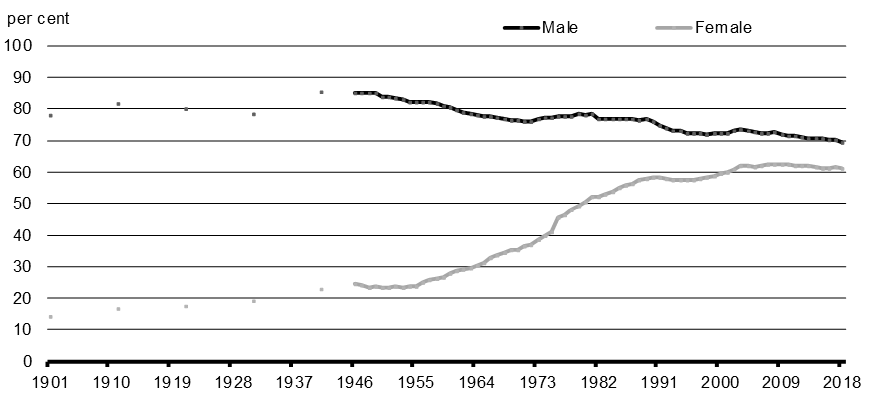
The factors contributing to the gender wage gap are numerous and complex, but one important factor is persistent social norms that place additional care and family responsibilities on women. Women spend significantly more time than men doing unpaid domestic and caregiving work, which can have an impact on the number of hours they work at more formal, paid labour. Research has also shown that women can face discrimination in hiring and salary decisions, and that mothers can be evaluated as less competent and committed to paid work than women without children. The impact on earnings when women become mothers is often termed the “motherhood penalty.” Since earnings are an important factor in Employment Insurance benefits, pensions and savings, these differences can have important long-term impacts on welfare.
| Men ($) | Women ($) | Gap Relative to Men (%) | Gap Relative to Total Population of Men (%) | |
|---|---|---|---|---|
| Total population | 40,600 | 28,500 | 30 | 30 |
| Visible minorities | 32,600 | 25,000 | 23 | 38 |
| Recent immigrants | 30,200 | 19,000 | 37 | 53 |
| Indigenous Peoples | 30,900 | 23,100 | 25 | 43 |
Supporting Economic Participation and Prosperity
Recent Actions
- Multilateral Early Learning and Child Care Framework: Through Budgets 2016 and 2017, the Government of Canada committed $7.5 billion over 11 years for more high-quality affordable child care. Through these investments, the government is on track to create up to 40,000 more child care spaces across the country by 2020. As part of this investment, a new distinctions-based Indigenous Early Learning and Child Care Framework—co-developed with the Assembly of First Nations, Inuit Tapiriit Kanatami, the Métis National Council—is delivering $1.7 billion over 10 years since 2018-19 to strengthen services for Indigenous families. These investments are in addition to support provided through the Canada Child Benefit, the Canada Social Transfer, and new Parental Leave programs. Leading into 2020, the Government will negotiate renewed early learning and child care agreements with provinces and territories, while seeking additional investments, more transparency, and better outcomes from underperforming partners.
- Employment Insurance (EI) Parental Sharing Benefit: Starting March 17, 2019, three months earlier than originally planned, this benefit will provide additional weeks of EI parental benefits when both parents agree to share parental leave, thereby encouraging greater equality in the distribution of family, child care and home responsibilities. A more equitable parental leave will also help lead to more equitable hiring practices, reducing conscious and unconscious bias by employers.
- Proactive Pay Equity Regime: This new proactive pay equity regime, which received Royal Assent on December 12, 2018, will contribute to enhancing fairness in the workplace by ensuring men and women in federally regulated sectors receive the same pay for work of equal value.
- Pay Transparency: Budget 2018 provided $3 million over five years to implement pay transparency for federally regulated employers. Pay transparency will require federally regulated private sector employers to report the wage gap for women, Indigenous Peoples, persons with disabilities and members of visible minorities.
- Labour Market Information (LMI): Building on a commitment to enhance the quality of LMI, including the launch of a one-stop national labour market information portal, Employment and Social Development Canada and Statistics Canada are working to improve the quality of labour market information and its accessibility to Canadians, in partnership with the recently established Labour Market Information Council. Statistics Canada has begun to release articles providing insights on post-secondary enrolments, post-secondary graduates, labour market outcomes for college and university graduates, as well as earnings indicators for registered apprentices.
- Visible Minority Newcomers: Budget 2018 announced funding of $31.8 million over three years, starting in 2018-19, to launch a 3-year pilot to support programming for newcomer women who are also visible minorities to help them get into and stay in the workforce.
Supporting Economic Participation and Prosperity
Budget 2019 Actions
- Launching a modernized Youth Employment Strategy that helps youth gain the skills and experience they need to find a job by offering a suite of supports tailored to their needs.
- Investing in work-integrated learning by expanding the Student Work Placement Program, investing in additional placement opportunities, and partnering with the Business/Higher Education Roundtable to support up to 84,000 new work placements per year by 2023-24 for post-secondary students across Canada.
- Making it easier for workers and employers to navigate the wide variety of skills development programs, and ensuring that the programs reflect employers’ needs by simplifying access to skills programming and emphasizing skills innovation and experimentation with partners to ensure programs respond to changing labour market needs.
- Improving employment of persons with visual impairments.
- Identifying, removing and preventing technological barriers in federal government workplaces.
- Consulting with Indigenous communities on major energy projects and supporting Indigenous economic participation in the natural resource sectors.
- Promoting apprenticeships in skilled trades and technology as viable career paths through the Skills Canada Program and a new Apprenticeship Campaign.
- Developing a new strategy to support apprentices and those employed in the skilled trades, ensuring that programs effectively target the barriers to entry and aid progression for Canadians who want to work in the skilled trades.
- Introducing new requirements for federally regulated financial institutions to disclose policies aimed at promoting greater diversity on boards and in senior management.
Leadership and Democratic Participation
Gender equality and diversity in leadership and at all levels of decision-making are essential to a fair and democratic society. The Government has taken steps to encourage diversity in economic, political and judicial spheres.
Key Gender Results Indicators: Where We Stand
Goal: More women in senior management positions, and more diversity in senior leadership positions
- Women accounted for 48 per cent of employment in 2018, but only 33 per cent of those employed in senior management. Women accounted for only 9 per cent of C-suite executives at Canada's 100 largest publicly traded corporations.
Goal: Increased opportunities for women to start and grow their business, and succeed on a global scale
- In 2017, 16 per cent SMEs were majority-owned by women. Of those that are exporters, 15 per cent were majority-owned by women.
- Visible minorities held the majority ownership of 12 per cent of SMEs in 2017, Indigenous Peoples held 1 per cent, and people with disabilities held 1 per cent.
Goal: More company board seats held by women, and more diversity on company boards
- In 2018, 25 per cent of FP500 board seats were held by women. Indigenous Peoples, visible minorities, people with disabilities and LGBTQ2+ represented 1 per cent, 6 per cent, 1 per cent and 1 per cent of directors, respectively.
Goal: Greater representation of women and underrepresented groups in elected office and ministerial positions in national and sub-national governments
- Women account for 27 per cent of federal Members of Parliament, 47 per cent of federal Cabinet Ministers, and 47 per cent of federal Senators.
- Only one of 13 Premiers, about one in three cabinet members and elected officials in provincial and territorial governments are women.
- 13 per cent of mayors and 36 per cent of councillors are women in municipalities with over 200,000 inhabitants, while 28 per cent of councillors and 21 per cent of Chiefs of First Nations Band Councils are women.
Goal: Increased representation of women and underrepresented groups as administrators of the justice system
- In 2017-18, of the 79 appointments to the federal judicial system over the year starting October 2017, 46 were women, 3 were Indigenous, 7 were visible minorities, 11 identified as part of an ethnic or cultural group, 2 were persons with disabilities, and 6 identified as LGBTQ2+.
- In 2017, women represented 21 per cent of police officers across all police forces in Canada. In the Royal Canadian Mounted Police, about one-fifth are women. In 2016, visible minorities represented 22 per cent of the population but only 8 per cent of police officers, while Indigenous Peoples represented 5 per cent, roughly equal to their share of the population.
Sources: Labour Force Survey; Women in Capital Markets; 2017 Survey on Financing and Growth of Small and Medium Enterprises; Canadian Board Diversity Council; House of Commons; Senate; Indigenous Services Canada; Office of the Commissioner for Federal Judicial Affairs Canada; Police Administration Survey; Royal Canadian Mounted Police; 2016 Census.
Women and diversity in leadership is good for business, and good for Canada’s economy. In less than two decades, women’s representation on the boards of Canada’s largest corporations has significantly improved; however, women still represent only a small portion of company board members. In the Financial Post 500 (FP500) ranking, which includes public firms, private companies, subsidiaries and Crown corporations, women accounted for 25 per cent of board seats in 2018, up from 11 per cent in 2001.
Taking into account only publicly listed companies, Canada ranked 15th out of 36 OECD countries, with women holding 26 per cent of board seats in 2017. Although Canada’s share was higher than the OECD average (22 per cent), it was below that of France (43 per cent) and all other Group of Seven (G7) countries except the United States and Japan.
Proportion of Women FP500 Board Members, 2001-2018
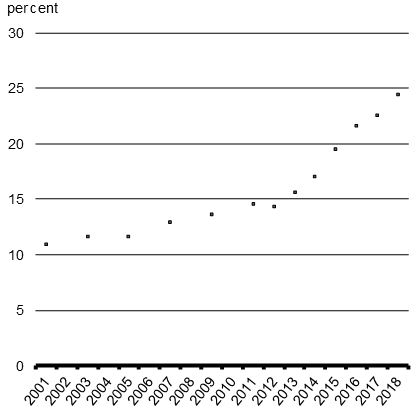
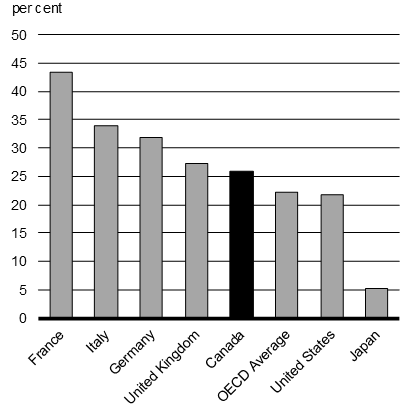
Diversity in public institutions is particularly important as these bodies create and enforce legislation that can significantly influence people’s day-to-day lives. Over the last generation, there has been important progress in terms of gender representation in political life. For example, women currently represent almost half of the Cabinet Ministers at the federal level and almost half of the Senators. However, there continues to be underrepresentation of women in the federal House of Commons, with women accounting for only slightly more than one-quarter of the Members of Parliament. This places Canada’s gender representation in the lower house below that of all G7 countries except the United States and Japan.
Share of Women Federal Members of Parliament and Cabinet Appointments, 14th - 42nd Parliament
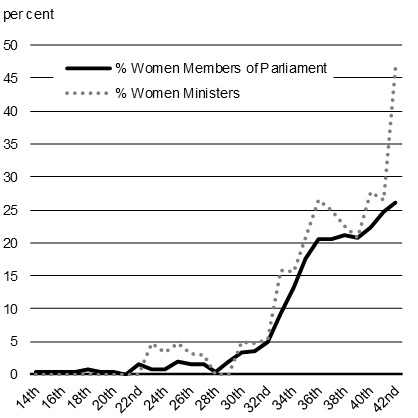
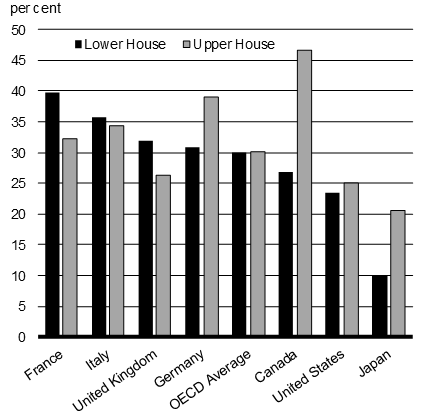
There has also been significant progress toward gender equality in new appointments and elevations of judges to superior courts in Canada. For example, in 2006-07, women represented only 30 per cent of new appointments and 36 per cent of elevations, while in 2017-18, women accounted for 58 per cent of new appointments and elevations. Starting in 2016-17, the Office of the Commissioner for Federal Judicial Affairs also started collecting data on diversity, including on Indigenous Peoples, visible minorities, people identifying as belonging to an ethnic or cultural group, persons with disabilities, and persons identifying as LGTBQ2, to better understand how appointments and elevations of judges to superior courts reflect the diversity of the Canadian experience.
Promoting Leadership and Democratic Participation
Recent Actions
- Governor-in-Council Appointees: Since the implementation of the new nomination process for Governor-in-Council (GIC) appointments, the gender representation of women serving as GIC appointees has increased from 34 per cent in late 2015 to 47 per cent today.
- Diversity on Corporate Boards: Bill C-25 became law on May 1, 2018. It includes the provision that publicly traded corporations regulated by the Canada Business Corporations Act are required to provide shareholders with information on the corporations' policies related to diversity (beyond gender) on the board of directors and within senior management.
- GBA+ Forum: In November 2018, the Department for Women and Gender Equality hosted the first ever GBA+ Forum, a national dialogue on improving the effectiveness of GBA+, sharing best practices and reflecting on challenges and successes. More than 1,000 participants took part in person and online from all levels of government, as well as civil society—including non-governmental organizations, academics, leaders from the private sector and international stakeholders.
- Work-Life Balance for Members of Parliament: Amendments to the Parliament of Canada Act allow the House of Commons and the Senate to adopt regulations permitting parental leave. The Government also announced its intention in Budget 2018 to work toward better accommodation for Members of Parliament with young children, notably by providing child care and designated spaces for their use.
- Women Entrepreneurship Strategy: Budget 2018 announced the Women Entrepreneurship Strategy, a comprehensive, whole-of-government plan investing nearly $2 billion to help women start and grow their businesses, responding to the advice of the Canada-United States Council for Advancement of Women Entrepreneurs and Business Leaders. Through multiple investments, women entrepreneurs (including diverse and underrepresented women) and their businesses will benefit from increased access to financing, talent, networks and expertise.
- Women's Program: Budget 2018 invested $100 million to build the capacity of women's and equality-seeking organizations and reduce gender inequality by supporting initiatives such as Daughters of the Vote.
Promoting Leadership and Democratic Participation
Budget 2019 Actions
- Enhancing the funding of the Métis Capital Corporations to support the start-up and expansion of Métis small and medium-sized enterprises.
- Expanding the Aboriginal Entrepreneurship Program.
- Creating the Indigenous Growth Fund to allow all Aboriginal Financial Institutions, including Métis Capital Corporations and others, to support more Indigenous entrepreneurs and more ambitious projects.
- Investing in Futurpreneur Canada so that it can continue supporting the next generation of entrepreneurs.
- Supporting the construction of an Indigenous Legal Lodge at the University of Victoria. The Indigenous Legal Lodge will house the university’s new dual degree program in Canadian Common Law and Indigenous Legal Orders, and will serve as a foundation for debate, learning, public education and partnership on the revitalization of Indigenous laws.
- Enhancing the Women’s Program to advance gender equality in Canada, including support for projects that will encourage women and girls in leadership and decision-making roles.
- Introducing new requirements for federally regulated financial institutions to disclose policies aimed at promoting greater diversity on boards and in senior management.
Gender-Based Violence and Access to Justice
All Canadians should be safe and free from physical, emotional or sexual violence, discrimination and harassment. The Government is taking steps to prevent violence and workplace harassment, enhance support for survivors, and improve the responsiveness and accountability within the criminal justice system.
Key Gender Results Indicators: Where We Stand
Goal: Workplaces are harassment-free
- Women are victims of workplace harassment more often than men. In 2016, 19 per cent of working-age women and 13 per cent of men reported experiencing workplace harassment in the past 12 months.
Goal: Fewer women are victims of intimate partner violence and sexual assault
- Women are overrepresented as victims of police-reported intimate partner violence. In 2017, women accounted for almost 8 out of 10 victims.
- Women are more than 7 times more likely to be victims of sexual assault than men. In 2013-2014, there were 37 self-reported incidents of sexual assault for every 1,000 women aged 15 years and older.
Goal: Fewer victims of childhood maltreatment
- More men recall experiencing childhood maltreatment than women. In 2014, 32 per cent of men and 27 per cent of women reported experiencing physical and/or sexual abuse before the age of 15 years.
Goal: Fewer women killed by an intimate partner
- Women were 5 times more likely to be killed by an intimate partner than men. In 2017, the rate of intimate partner homicide was 0.41 per 100,000 women, while it was 0.08 per 100,000 men. Women accounted for 84 per cent of homicide victims killed by an intimate partner in 2017.
Goal: Increased police reporting of violent crimes
- Sexual assault incidents were the least likely to be reported to the police of all incidents of violent victimization. In 2014, 83 per cent of sexual assault incidents were not reported to the police, compared to 54 per cent of robbery incidents and 60 per cent of physical assault incidents.
Goal: Fewer Indigenous women and girls are victims of violence
- Indigenous women are more likely to experience sexual assault. In 2014, Indigenous women recorded a sexual assault rate of 113 incidents per 1,000 women, more than three times higher than the rate for
non-Indigenous women and more than 22 times higher than the rate for non-Indigenous men. - In late 2013, the RCMP initiated a study of reported incidents of missing and murdered Indigenous women across all police jurisdictions in Canada. There were 1,181 police-reported incidents of Indigenous women homicides and unresolved missing Indigenous women. In 2013, Indigenous women made up approximately 11 per cent of all missing women and roughly 16 per cent of all homicides where women are victims, higher than their population share at the time of 4 per cent.
Goal: Increased accountability and responsiveness of the Canadian criminal justice system
- In 2017, 14 per cent of sexual assaults reported to all police forces in Canada (e.g., federal, provincial, municipal) were classified as unfounded, down from 19 per cent in 2016.
Sources: 2016 General Social Survey; 2014 General Social Survey; Uniform Crime Reporting Survey; Homicide Survey; Royal Canadian Mounted Police.
Discrimination, harassment and violence in the workplace can have profound negative effects on health and safety, absenteeism and productivity. Workplace harassment, which includes verbal abuse, humiliating behaviour, threats to the person, physical violence and unwanted sexual attention or sexual harassment, can be experienced by anyone, regardless of gender, race, ethnicity, religion or sexual orientation. In 2016, women were more likely to report experiencing workplace harassment than men, with gender differences most pronounced for cases of verbal abuse and unwanted sexual attention or sexual harassment.
Physical and sexual violence can also occur in childhood, and is often accompanied by profound and long-lasting negative impacts, sometimes spanning generations. Individuals who experience childhood maltreatment are also more than twice as likely to experience violent victimization as adults. In 2014, a higher share of men than women aged 15 years and older reported childhood maltreatment, although women were more likely to report being sexually abused, while men were more likely to report being physically abused.
Proportion of Self-Reporting Harassment in the Workplace by Type of Harassment and Gender
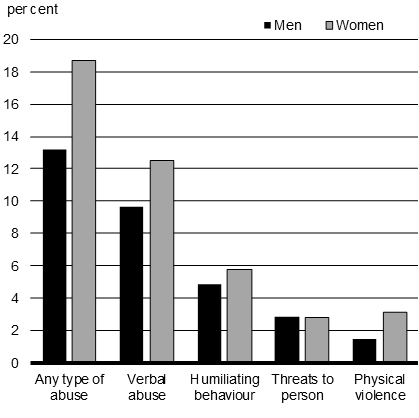
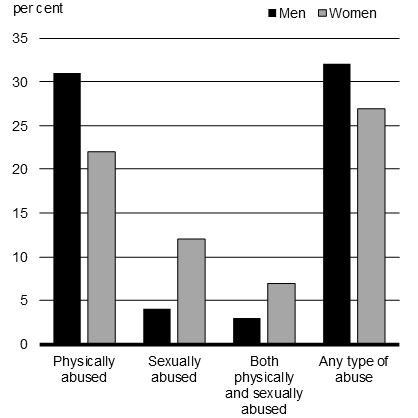
Indigenous girls and young women are overrepresented among victims of violence. Although only 7 per cent of young women and girls are Indigenous, they accounted for 34 per cent of the homicide victims that were young women or girls over the past decade.
Addressing Gender-Based Violence and Improving Access to Justice
Recent Actions
- Canada's Strategy to Prevent and Address Gender-Based Violence: The Government has invested nearly $200 million, and over $40 million per year ongoing, for new and expanded initiatives related to gender-based violence. The initiatives are organized across the strategy's three pillars: Preventing Gender-Based Violence, Supporting Survivors and their Families, and Promoting Responsive Legal and Justice Systems, and are coordinated through the Gender-Based Violence Knowledge Centre, launched on December 10, 2018.
- Workplace Harassment: The Government has invested $50.4 million over five years to boost legal aid across the country, to support victims of sexual harassment in the workplace, and to establish a pan-Canadian outreach and awareness campaign. The Government also invested $34.9 million over five years and $7.4 million per year ongoing to support the implementation of Bill C-65, which was passed on October 25, 2018 to ensure federal workplaces are protected from harassment and violence. Funding has been allocated towards regulatory development, the training and hiring of new special investigators, and the development of educational materials and tools. Additionally, an outreach Hub to support employees has been staffed and running since March 2018.
- Canadian Human Rights Act and Criminal Code: Legislation on gender identity and gender expression became law in June 2017 protecting individuals from discrimination based on gender identity and gender expression in the Act. It also expands the reasons in the Criminal Code for longer sentences for hate-motivated criminal offences to include gender identity and gender expression.
- Unified Family Courts: Budget 2018 proposed $77.2 million over four years and $20.8 million per year ongoing to support the creation of 39 new Unified Family Court judicial positions. These courts will help streamline family justice for Canadians, contributing to better outcomes for families.
- Unfounded Sexual Assault Cases: Budget 2018 provided the RCMP with $10 million over five years and $2 million per year ongoing to increase the RCMP's capacity to address sexual assault complaints coded as "unfounded." In particular, the RCMP is taking action to strengthen police training and awareness, investigative accountability, victim support, public education and communication.
- National Housing Strategy: This strategy prioritizes the most vulnerable Canadians, including women and children fleeing family violence. The $13.2 billion National Housing Co-Investment Fund, launched in May 2018, will help build 60,000 new units and repair or renew 240,000 units. This includes 4,000 shelter spaces for survivors of family violence, which will help reduce wait times for beds, and help women who might otherwise return to abusive relationships or turn to the streets. This is in addition to Budget 2016 funding to create 3,000 shelter spaces. The Co-Investment Fund is also encouraging partnerships between housing projects and support services to help those experiencing mental health or addiction challenges.
- National Framework to Prevent Gender-Based Violence on Campus: Budget 2018 committed $5.5 million over five years to work with stakeholders, including provincial and territorial governments, to develop a framework to prevent and address gender-based violence at post-secondary institutions.
- National Inquiry into Missing and Murdered Indigenous Women: Budget 2016 and subsequent funding provided $53.9 million to launch the National Inquiry into Missing and Murdered Indigenous Women and Girls. In June 2018, in response to the Interim Report, the Government provided: $21.3 million over three years to increase health supports and victim services for survivors and families; $5.42 million to extend the availability of Family Information Liaison Units and funding for community-based organizations to support families beyond the life of the Inquiry; $10 million over two years to establish a commemoration fund; $1.25 million over two years to fund organizations with expertise in law enforcement and policing to lead a review of police policies and practices; and $9.6 million over five years to support the Royal Canadian Mounted Police's new National Investigative Standards and Practices Unit. The Inquiry's Final Report will be released in April 2019.
Addressing Gender-Based Violence and Improving Access to Justice
Budget 2019 Actions
- Supporting efforts to combat the sexual exploitation of children online.
- Supporting Indigenous law initiatives across Canada through the Justice Partnership and Innovation Program, to improve equality for Indigenous Peoples in Canada’s legal system.
- Announcing the Government’s intention to develop a new, whole-of-government strategy to combat human trafficking.
- Supporting the growing demand for Public Legal Education and Information services across Canada.
- Supporting legislative amendments for increased access to family justice—and divorce in particular—in the official language of one’s choice.
- Enhancing the Women’s Program to advance gender equality in Canada, including support for projects that will address gender-based violence.
Poverty Reduction, Health and Well-Being
All Canadians should have a real and fair opportunity to succeed, including resources to ensure their basic needs are met. The Government’s new Poverty Reduction Strategy provides clear targets to reduce poverty based on Canada’s Official Poverty Line. It will also help support Canadians working hard to join the middle class and build a diverse, prosperous and truly inclusive country, where all can realize their full potential. Due in part to the recent investments of the Government, such as the Canada Child Benefit, Canada has achieved its targeted 20 per cent reduction of poverty three years ahead of time, lifting over 825,000 Canadians out of poverty compared to 2015.
Key Gender Results Indicators: Where We Stand
Goal: Fewer vulnerable individuals living in poverty
- In 2017, 9.4 per cent of men and 9.6 per cent of women were below the poverty line, defined by the cost of a basket of essential goods and services.
- People in lone-parent households headed by women were more likely to be in poverty than people living in couples (25 per cent versus 7 per cent).
Goal: Fewer women and children living in food insecure households
- Food insecurity occurs when a household must compromise in quality and/or quantity of food consumed, or reduce food intake and disrupt eating patterns. In 2011-12, 7 per cent of men aged 12 years and over lived in food insecure households, compared to 9 per cent of women. Lone-parent households were significantly more likely to face food insecurity than households led by couples (23 per cent compared to 7 per cent).
Goal: Fewer vulnerable individuals lacking stable, safe and permanent housing
- A household in core housing need is one whose dwelling is considered unsuitable, inadequate or unaffordable and who could not afford alternative adequate housing in their community. In 2016, 26 per cent of women who were lone parents lived in core housing need, compared to 11 per cent of all women and 10 per cent of all men.
- In 2016, 18 per cent of the visible minority population was in core housing need, compared to 9 per cent of the non-visible minority population.
Goal: Child and spousal support orders are enforced
- In 2016-17, only 71 per cent of the total support payments in active cases was collected when both the spouse and child are beneficiaries, lower than when only the child (77 per cent) or only the spouse (85 per cent) is the beneficiary.
Goal: More years in good health
- A girl born in 2015 had an expected 71 years in good health compared to 69 years for a boy.
- The leading cause of death for men and women in 2016 was malignant neoplasms (cancerous tumours) followed by diseases of the heart. In both cases, the death rate was higher for men than for women. Deaths caused by intentional self-harm were significantly higher among men (16 per 100,000) than among women (6 per 100,000).
- In 2015, 96 per cent of girls aged 5-17 years were not meeting the physical activity guidelines compared to 88 per cent of boys. 82 per cent of men and 83 per cent of women aged 18-79 years were not meeting the guidelines.
Goal: Improved mental health
- In 2017, 68 per cent of women aged 12 years and over self-reported a high level of mental health compared to 73 per cent of men.
- Indigenous Peoples have significantly higher rates of suicide.
Goal: Improved access to contraception for young people and reduced adolescent birth rate
- Of those sexually active aged 15-34 years not trying to conceive and not pregnant, 29 per cent did not use a condom or other method of contraception during their last sexual intercourse.
- In 2017, the adolescent birth rate was 7.9 live births per 1,000 women aged 15-19 years, down from 17.3 live births per 1,000 women in 2000.
Sources: Canadian Income Survey; 2011-2012 Canadian Community Health Survey; 2016 Census; Survey of Maintenance Enforcement Programs; Vital Statistics – Death Database; Vital Statistics – Birth Database; Canadian Health Measures Survey; Canadian Community Health Survey – Annual Component; Department of Finance Canada calculations.
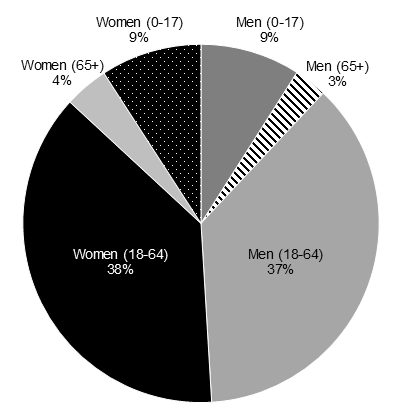
In 2017, women and men were almost equally likely to face poverty, although there were important differences for specific subgroups of women. For example, lone-parent households led by women were much more likely to face food insecurity and lack appropriate housing than lone-parent households led by men or couple households.
Other underrepresented groups also face an elevated risk of poverty and lack of appropriate housing and/or food security. Indigenous Peoples, recent immigrants and persons with disabilities are particularly at risk. For example, 1 in 4 recent immigrants and almost 4 in 10 Inuit are in core housing need.
Underrepresented Groups, 2016
Poverty is closely linked to longevity. For example, boys born into the poorest households in Canada in 2010-2012 are expected to live 76 years, while boys born into the richest households in Canada in the same years could expect to live 81 years. Girls born into the poorest households faced a smaller gap, but could still expect to live 2.4 years less than those born into the richest households.
Poverty can also lead to significantly lower levels of mental and physical health. In particular, individuals living in the poorest households were less likely to report very good or excellent mental or physical health than those in the richest households. For all types of households, women are less likely to report very good or excellent mental health than men. However, the Canadian Mental Health Association notes that mental health problems may go undiagnosed among men because they find it relatively more difficult to acknowledge emotional symptoms compared to physical ones.
Reducing Poverty and Supporting Health and Well-Being
Recent Actions
- Canada Child Benefit: Introduced in Budget 2016, this benefit provides more money to low- and middle-income families to help with the high cost of raising children. Nine out of 10 Canadian families are receiving more in child benefits than they did under the previous system. The Canada Child Benefit has helped lift nearly 300,000 children out of poverty.
- Poverty Reduction Strategy: Released in August 2018, the Strategy introduced Canada's Official Poverty Line and set targets to reduce poverty by 20 per cent by 2020, which has already been reached, and 50 per cent by 2030 from 2015 levels. The Strategy also committed to the establishment of a National Advisory Council on Poverty, tasked to advise and publicly report progress toward poverty reduction.
- Indigenous Health and Safety: Since 2015, the Government has announced nearly $9 billion in infrastructure investments to improve the lives of Indigenous Peoples. Budgets 2017 and 2018 announced funding to reduce overcrowding and housing in disrepair through support for distinctions-based housing strategies and investments in the repair and construction of housing units in First Nations, Inuit and Métis Nation communities. Additional investments have provided over $3.1 billion to help close gaps in health outcomes between Indigenous Peoples and non-Indigenous Canadians. This includes the continued implementation of Jordan's Principle, which ensures that First Nations children can access public services that are typically available to other children, including health services. In addition, there have been investments to help address acute health issues, provide greater support for distinctions-based health care data collection and delivery, and expand Indigenous health systems that are increasingly delivered and controlled by Indigenous Peoples. As key social determinants of health, budget investments in housing, infrastructure and safe drinking water have also contributed to positive health outcomes for Indigenous communities. Since November 2015, more than 80 of 105 long-term drinking water advisories have been lifted on public systems on-reserve.
- Home Care and Mental Health: In Budget 2017, the Government committed $11 billion over 10 years to provincial and territorial governments to support home care and mental health. This funding will help more Canadians to receive better care at home or in their community. It will also help expand access to community-based mental health and addiction services, particularly for children and youth.
- Mental Health Supports for Inmates: The Correctional Service of Canada implemented a full intermediary mental health care staffing model in maximum-security units in each of its five regional women's institutions. It is also working to expand access to in-patient psychiatric care for women in federal corrections.
- National Housing Strategy: Launched in November 2017, the initiative sets ambitious targets of removing 530,000 families from housing need, cutting chronic homelessness by 50 per cent, renovating and modernizing 300,000 housing units and building 100,000 new units for families in need. Under this Strategy, in May 2018, the Government launched the National Housing Co-Investment Fund to provide loans and contributions to support the creation or repair of affordable homes, which has seen positive uptake. In addition, a redesigned federal homelessness program, to be called Reaching Home, will be launched in April 2019.
Reducing Poverty and Supporting Health and Well-Being
Budget 2019 Actions
- Enhancing the Guaranteed Income Supplement earnings exemption to improve the economic security of lower-income seniors.
- Supporting the implementation of Canada’s first National Dementia Strategy.
- Introducing legislation to proactively enroll Canada Pension Plan contributors who are age 70 or older in 2020 but have not yet applied to receive their retirement pension, ensuring Canadian seniors have access to the benefits to which they are entitled.
- Supporting Prince Edward Island’s Public Safety Housing Project to assist individuals with complex health and social needs.
- Implementing Jordan’s Principle, while work continues to develop a longer-term approach.
- Continuing work with Inuit partners to address the immediate needs of Inuit children and their unique challenges accessing health and social services.
- Ensuring the Assisted Living Program continues to meet the needs of seniors and people with disabilities on-reserve.
- Engaging with First Nations and Inuit communities in the development of a long-term care strategy.
- Supporting the construction and ongoing operation of a treatment facility in Nunavut, help ensure that Inuit and other residents of Nunavut have access to mental health and substance use supports.
- Supporting ongoing efforts to eliminate and prevent long-term drinking water advisories in First Nations communities.
- Ensuring that urban Indigenous residents have safe and accessible spaces to access culturally-relevant services, through capital infrastructure investments in Friendship Centres and other Urban Programming for Indigenous Peoples service provider facilities.
- Supporting seniors’ participation and inclusion in their communities through the New Horizons for Seniors Program.
- Ensuring refugees and other eligible claimants have access to temporary health coverage under the Interim Federal Health Program, easing the health care costs of provincial and territorial governments.
- Creating a pan-Canadian database for organ donation and transplantation.
- Enhancing the Federal Government’s response to the opioid crisis.
- Expanding the reach of the National Inuit Suicide Prevention Strategy to enhance access to Inuit-specific mental health supports.
- Supporting a Pan-Canadian Suicide Prevention Service.
Gender Equality Around the World
Despite important advances over the last two decades, women and girls around the world continue to face unequal access to resources, opportunities and security that prevent them from realizing their full potential. Full and equal participation of women and girls can lead to greater prosperity, improved quality of life and peace and security for everyone. For these reasons and more, Canada is applying a feminist lens across all international policies.
Key Gender Results Indicators: Where We Stand
Goal: Increased and meaningful participation of women in peace and security efforts
- In 2018, women comprised only 5 per cent of combined UN police and military personnel in peacekeeping missions. Evidence shows that the inclusion of women in peacekeeping has benefits for effective operations.
Goal: More women in leadership and decision-making roles, and stronger women's rights organizations
- While evidence shows that women's rights organizations are the single most significant factor in influencing policy changes towards gender equality, only 0.5 per cent of the total amount of aid earmarked for OECD gender specific programming went to women's rights organizations in 2014.
- Between 1997 and 2019, the global average of women members of parliament rose from 12 per cent to 24 per cent.
Goal: More women and girls have access to sexual and reproductive health services, and their rights are promoted
- There were an estimated 89 million unintended pregnancies in developing countries in 2017, and every day approximately 830 women die from preventable causes related to pregnancy and childbirth, with adolescent girls facing an even higher risk of complications and death.
Goal: More of Canada's trade agreements include gender-related provisions
- Canada's new and revised trade agreements include gender provisions, including free trade agreements with Chile and Israel, the Canada-United States-Mexico Agreement, and the Comprehensive and Progressive Agreement for Trans-Pacific Partnership.
Goal: More women have equitable access to and control over the resources they need to build their own economic success and the economic success of their communities
- In 2018, nearly 40 per cent of countries worldwide imposed constraints on women's right to own property, 104 countries had laws preventing women from working specific jobs, and in 18 countries husbands could legally prevent their wives from working.
Goal: Fewer people are victims of sexual and gender-based violence and sexual exploitation, including in conflict settings and online
- 1 in 3 women worldwide are estimated to have experienced physical and/or sexual intimate partner violence or sexual violence by a non-partner, and at least 200 million women and girls worldwide have been subjected to female genital mutilation, of which 44 million are girls below age 15.
Goal: More girls and women access quality education and skills training
- Women make up more than two-thirds of the world's nearly 750 million illiterate people, and in conflict zones girls are 2.5 times more likely than boys to be out of school entirely.
Sources: United Nations Department of Peacekeeping Operations; Inter-Parliamentary Union; Global Affairs Canada; World Bank; United Nations Children's Fund (UNICEF); United Nations Women.
In the past generation, the world has made steady advances towards gender equality and the empowerment of women and girls. Since the UN's Fourth World Conference on Women in 1995, international frameworks have been established to promote gender equality and important progress has been made in some areas. For instance, between 2005 and 2017 the number of women holding ministerial positions in government increased by 44 per cent, and women now make up half or more of those attending university in 93 countries worldwide.
However, important gaps remain as only 63 per cent of women aged 25-54 participate in the formal labour market, compared to 94 per cent of men.
Moreover, momentum towards gender equality has recently stalled. Just last year the United Nations warned that international progress on gender equality was “unacceptably slow”—a claim backed up by mounting evidence. For example, the World Economic Forum confirms that, despite significant variation across countries and regions, global progress towards gender equality—as measured by an index of equality in health and survival, educational attainment, political participation, and economic participation and opportunity—has plateaued.
Though gaps between men and women have narrowed substantially in measures of health and educational attainment, persistent and significant gender gaps remain in the areas of political and economic empowerment. For example, women today are three times less likely than men to hold leadership positions as legislators, senior officials or managers. According to the United Nations Office on Drugs and Crime, women and girls also account for 71 per cent of global human trafficking victims, most of whom are trafficked for the purpose of sexual exploitation.
In this light, Canada has been moving forward decisively on an agenda that advances gender equality and the empowerment of women and girls at home and abroad. This goal matters not only because promoting gender equality is the right thing do, but because increasing evidence shows that the full participation of women and girls leads to more inclusive and sustainable results, whether in conflict resolution and peacebuilding, realizing the potential of trade agreements, or contributing to economic growth and development.
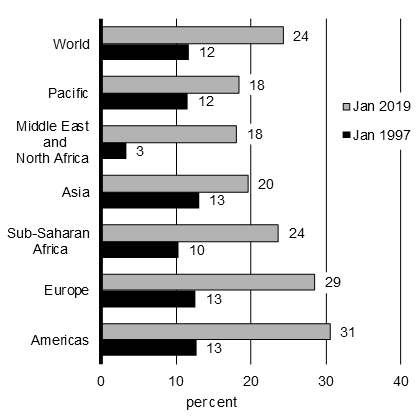
Supporting Gender Equality Around the World
Recent Actions
International Trade and Investment
- To help ensure that the benefits of international trade and investment are more widely shared, Canada achieved gender provisions in modernized free trade agreements with Chile and Israel, the Canada-United States-Mexico Agreement, and the Comprehensive and Progressive Agreement for Trans-Pacific Partnership.
- The Business Women in International Trade program led three trade missions involving over 125 women-owned businesses and business support organizations.
- In multilateral forums like the UN and the G20, Canada works to advance women's economic empowerment, including upholding their right to own property and participate in the labour market, and improving access to finance and global value chains through initiatives such as the Women Entrepreneurs Finance Initiative (We-Fi).
Diplomacy
- At the 2018 G7 Charlevoix Summit, Canada created the G7's first Gender Equality Advisory Council and led G7 partners in committing to meaningful action to help improve the lives of women and girls around the world, including leveraging $3.8 billion to support women's and girls' education in conflict, post-conflict and crisis situations.
- Underscoring the benefits of integrating a gender perspective in international affairs, Canada and the European Union co-hosted the world's first formal Women Foreign Ministers' Meeting.
- Canada's diplomatic representation has made substantial progress towards gender balance. In 2018, 48 per cent of heads of missions—ambassadors, high commissioners and consuls general—were women, up from 32 per cent in 2015.
Peace and Security Operations
- To spur transformational change regarding women's meaningful participation in UN peace operations, Canada launched the Elsie Initiative for Women in Peace Operations and spearheaded the G7 Women, Peace and Security Partnerships Initiative.
- Budget 2018 invested $20.3 million over five years to welcome an extra 1,000 vulnerable women and girls from various conflict zones around the world as government-assisted refugees in Canada.
International Development Assistance
- Through the Women's Voice and Leadership Program, Canada supports women's organizations and networks in over 30 developing countries, strengthening their ability to promote women's rights, women's empowerment, and gender equality.
- To catalyze new investments in support of women and girls in developing countries, Canada launched a new Partnership for Gender Equality, bringing together the Government of Canada, the philanthropic community, the private sector and civil society.
- To enable the fight against sexual and gender-based violence, including female genital mutilation, Canada launched the Her Voice, Her Choice initiative.
Supporting Gender Equality Around the World
Budget 2019 Actions
- Renewing Canada's Middle East Strategy to aid and reduce the vulnerability of conflict-affected populations, particularly women, girls and other vulnerable groups, and bolster the participation of women in the peace process in Syria and the reconciliation processes in Iraq.
- Increasing the World Bank’s capacity to support the achievement of the Sustainable Development Goals.
- Supporting the implementation of Canada’s Feminist International Assistance Policy through the International Assistance Envelope by investing an additional $700 million in 2023–24.
- Announcing the Government’s intention to develop a new, whole-of-government strategy to combat human trafficking.
GBA+ of Budget 2019
This year’s budget is about investing in people—middle class Canadians who work, every day, to make the country a better place to live. It includes measures to ensure all Canadians have the tools they need to find good jobs and succeed in the economy of the future. It builds upon the Government’s plan to grow the economy by addressing the changing nature of work and social challenges facing our country.
As the previous pages in this chapter illustrate, a great deal of work still needs to be done to narrow the gaps that exist not only between women and men, but also among historically underrepresented groups, such as Indigenous Peoples, visible minorities, and persons with disabilities. The diversity in Canadian society is a source of strength and a key driver of economic growth. Making policy decisions that help vulnerable Canadians learn new skills, participate in the economy, or improve their health and well-being leads to positive outcomes for everyone.
The Government’s efforts to enrich the quality of GBA+ have continued since the first Gender Statement in 2017, supported by investments in Statistics Canada and the Department for Women and Gender Equality. Enhanced GBA+ training was given to public servants developing and analyzing budget proposals. To strengthen the consistency and comparability of GBA+, a common set of information was collected for all budget proposals.
While certain measures (e.g., personal income tax measures, transfers to individuals) lend themselves naturally to GBA+ because of the direct nature of the disaggregated data, many measures have impacts that are more diffuse—making GBA+ more challenging, but nonetheless important. The remainder of this chapter tells the story of Budget 2019 from a GBA+ perspective, focusing on impacts of the budget as a whole. This analysis is complemented by the comprehensive analysis of individual measures found in the GBA+ Annex.
Strengthening the GBA+ Process
High-quality GBA+ requires early attention and robust data to develop effective options and strategies for delivering programs and services to Canadians. For GBA+ to be most valuable, it is ideally built directly into the early stages of the policy development process. Based on the information provided by departments that developed budget proposals, for 66 per cent of Budget 2019 measures the GBA+ was performed early in the development phase or had been performed on the existing program. This early engagement suggests a clear effort by the whole of government to incorporate gender and diversity considerations early in the policy process, but obviously leaves room for further improvement.
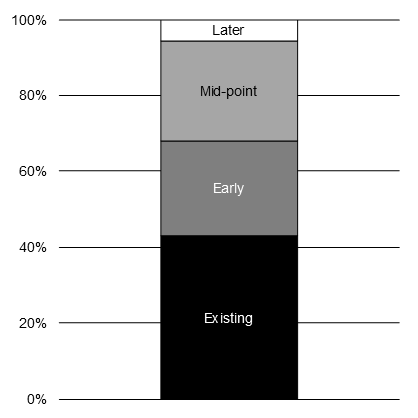
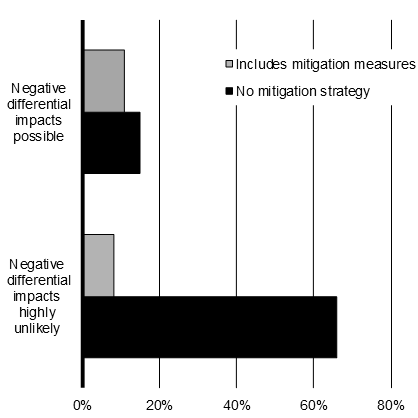
For some measures, the results of analysis can reveal challenges or barriers that could constrain the proposed program’s effectiveness for certain groups. In these instances, an important part of the GBA+ process is to develop specific approaches to mitigate these challenges and ensure the measure is available to as many Canadians as possible. Approximately 15 per cent of measures have identified the possibility of outcomes that could negatively impact some groups or perpetuate existing inequalities. For the majority of these measures, mitigation strategies have been developed to address possible negative differential impacts. A further 8 per cent of measures have proactively instituted approaches to minimize possible inequalities and help level the playing field, even where negative impacts are seen as highly unlikely. Establishing diversity policies, convening consultation groups or adjusting current processes to expand knowledge on the people impacted by the proposed program are some examples of proactive approaches.
Target Population for Budget Measures
All Government programs and policies are aimed at improving welfare and strengthening Canada’s economy and society. In some cases, these objectives are achieved through broad initiatives that are universally applied and seek to benefit all Canadians. In other cases, measures seek to help a specific group of the population, reflecting their particular challenges or opportunities. In Budget 2019, 86 measures, representing 40 per cent of the value of new budget measures, are intended to benefit all Canadians. An additional 83 measures, representing 49 per cent of the total value of new measures, were aimed at particular groups, and in a number of cases aimed at more than one of these groups. For example, implementing Jordan’s Principle seeks to help First Nations children and has been counted as targeting both First Nations and youth. 29 measures representing 11 per cent of the value of new budget measures, are aimed at particular regions or sectors. This section highlights some of the specific groups benefitting from Budget 2019 measures.
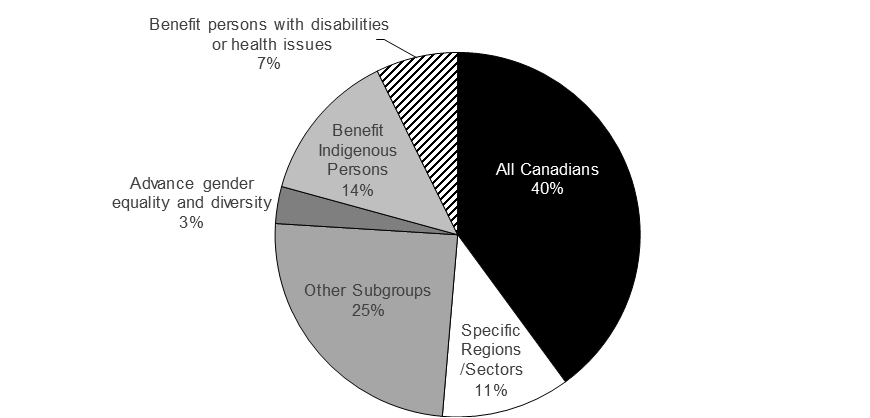
A Renewed Relationship With Indigenous Peoples
A number of measures in this budget are aimed at helping Indigenous Peoples. As discussed in Chapter 3, the Government has committed to chart a new path forward toward reconciliation and to renew the relationship between Canada and Indigenous Peoples. 24 measures in this budget are specifically aimed at helping First Nations, Inuit or Métis across a broad range of areas, including education, economic participation, and health and well-being. This includes the introduction of a variety of distinct post-secondary supports to help reduce the educational attainment gap, including a renewed and expanded First Nations Post-Secondary Student Support Program, and new ten year Inuit-led and Métis Nation-led post-secondary education strategies. Further investments are being made to increase labour market opportunities through Indigenous engagement on resource projects and support for First Nation and Inuit business development through the Community Opportunity Readiness Program. Budget 2019 also provides a number of investments in health and well-being, such as renewing and expanding the reach of the National Inuit Suicide Prevention Strategy, and implementing Jordan’s Principle to ensure timely medical care for First Nations children. Additionally, further investments are being made to provide First Nations communities across the country with access to clean drinking water.
Helping Persons With Disabilities and Health Issues
Key Measures Designed to Assist Persons With Disabilities and Health Issues
- $15.0 million over five years to make Canada Student Loans more accessible by making it more flexible for vulnerable student loan borrowers, such as students with permanent disabilities.
- $12 million to improve employment outcomes for persons with intellectual disabilities and Autism Spectrum Disorders.
- $13.7 million over five years to help identify, remove and prevent technological barriers in federal government workplaces.
- $25.8 million to support the production of accessible materials for persons with print disabilities.
- $1.0 million to improve employment of persons with visual impairments.
- $0.5 million towards innovation in accessible electronic payment terminals.
- Changes to allow the Registered Disability Savings Planto remain open after a change in status for the Disability Tax Credit at an estimated cost of $109 million, to better protect the long-term savings of persons with episodic disabilities.
- $50 million over five years to support the implementation of a National Dementia Strategy.
- $1.0 billion over two years to help Canadians with rare diseases access the drugs they need.
- $25 million over five years to support a pan-Canadian suicide prevention service through 24/7 crisis support from trained responders.
- $30.5 million for targeted measures to enhance the federal response to the Opioid crisis in Canada.
- Creating a pan-Canadian database for organ donation and transplantation
20 measures in this budget are specifically targeted at helping persons with disabilities, including those with chronic health issues. As persons with disabilities are more likely to be unemployed, to live in poverty and to earn less than people without a disability, supporting accessibility in Canada helps to support individuals while growing the economy.
The Public Health Agency of Canada notes that 44 per cent of adults over 20 years of age have at least one of the ten most common chronic health conditions. Because they tend to live longer, studies show that women have a higher incidence than men of suffering from chronic disease, especially for some like dementia, arthritis or osteoporosis, where age is a major risk factor. Budget 2019 is making over $2 billion over six years in targeted investments to improve the lives of Canadians with chronic health issues and to remove barriers experienced by persons with disabilities.
Supporting Youth
For the first time, the GBA+ measures in Budget 2019 include an increased focus on young people, providing almost $6 billion across a range of measures specifically aimed at helping Canada's youth. Today's youth are more educated, connected and diverse than ever before, but they also face their own challenges. While living a digital life and being highly connected brings many benefits, it also raises new vulnerabilities, such as the potential for online exploitation and cyberbullying, and for exacerbating mental health challenges. Evidence shows that girls, LGBTQ2+ and at-risk youth are most vulnerable to online exploitation, which is why this budget is making investments in raising awareness of online abuse and protecting some of the most vulnerable Canadians from harm. Boys, LGBTQ2+ (particularly transgender), and Indigenous youth face the highest rates of suicide. Investments in the Canada Suicide Prevention Service will facilitate access to around-the-clock crisis support from trained responders.
Key Budget 2019 Measures Designed to Assist Youth
- $1.7 billion in forgone revenue over five years, and $375.9 million per year ongoing, to lower the interest rate on Canada Student Loans and make the first six months after a borrower exits post-secondary education interest-free.
- Up to $314.8 million over the next five years, and $83.8 million per year ongoing, to implement the Canada Service Corps as Canada’s signature national youth service program.
- $15.2 million over three years, starting in 2019-20, for an Indigenous youth pilot program delivered by Canadian Roots Exchange, to help ensure that the voices of First Nations, Inuit, and Métis youth are heard and to support Indigenous youth reconciliation initiatives.
- $10 million over two years to support Let’s Talk Science, engaging youth in science, technology, engineering and mathematics (STEM), introducing them to critical skills development opportunities, and opening doors to future studies and occupations.
- $49.5 million over five years to launch a modernized Youth Employment Strategy that helps youth find jobs through a suite of supports tailored to their needs.
- $798.2 million over five years to invest in work-integrated learning by expanding the Student Work Placement Program, investing in additional placement opportunities, and partnering with the Business/Higher Education Roundtable to support up to 84,000 new work placements per year by 2023-24 for post-secondary students across Canada.
- $147.9 million over five years, and $8.0 million per year ongoing, to implement Canada’s new International Education Strategy.
- $38 million over five years to Futurpreneur Canada to support the next generation of entrepreneurs.
With the increased pace of globalization, automation and the application of artificial intelligence impacting the nature of employment, the Government understands that finding fulfilling full-time employment can be a challenge for today’s youth. That’s why Budget 2019 is modernizing the Youth Employment Strategy and making investments in the Student Work Placement Program so that youth can gain relevant experience and build networks upon which to grow their careers. The proposed expansion of the Canada Service Corps will create opportunities for youth to gain skills and leadership experience while making a meaningful difference in their communities.
Budget 2019 is also taking steps to address the hurdle of homeownership that many young people face today. Through changes to the Home Buyers’ Plan and the introduction of the new Shared Equity Mortgage Program, first-time home buyers have more options to leverage for purchasing their first home.
Indirect benefits are defined here as a second–order outcome. Examples include benefits realized by the group delivering the initiative or providing goods or services to those receiving the direct benefits, or by those benefitting from a connection with the direct beneficiaries (e.g., family members or individuals in the same region).
Major Beneficiaries
This section focuses on what GBA+ revealed about the benefits of Budget 2019 measures. While a policy objective might target a certain population, or Canadians as a whole, all measures carry impacts, whether direct or indirect, short or long term. For example, the Rental Construction Financing Initiative will directly benefit modest and middle income individuals and families in urban areas, but indirect benefits will go to those building the rental units in the construction industry.
Gender
The majority of measures in this budget carry direct benefits that are expected to be broadly felt by women and men in equal proportions, while others carry benefits that are likely to affect women or men differently. For 80 per cent of the value measures, the benefitting group was seen as broadly gender-balanced, while men or women were disproportionately represented in the benefitting group for 8 and 12 per cent of measures, respectively. This reflects the fact that men and women tend to participate in different sectors of the workforce, have different income levels, play different roles within a family and are unequally vulnerable to different challenges.
For example, although fathers are increasingly spending more time on child care, mothers still tend to serve as the primary caregivers within families. Consequently, while it is expected that some men will benefit from measures such as the new interest-free and payment-free medical and parental leave for student loan borrowers, and extending parental leave for graduate students, the majority of benefits from these initiatives are expected to be felt by women. Similarly, initiatives such as the increasing efforts to combat child sexual exploitation online and the implementation of a National Dementia Strategy will mostly improve the health and safety of women due to their risk factors being higher than those of men.
Conversely, measures like the Veteran Second Centre of Excellence will help all veterans, the majority of whom are men. Although measures like enhancing federal support for apprenticeships and investments in infrastructure would tend to directly or indirectly benefit men, the Government has taken a number of steps both in Budget 2019 and in previous budgets to encourage women to participate in apprenticeships and work in the construction trades.
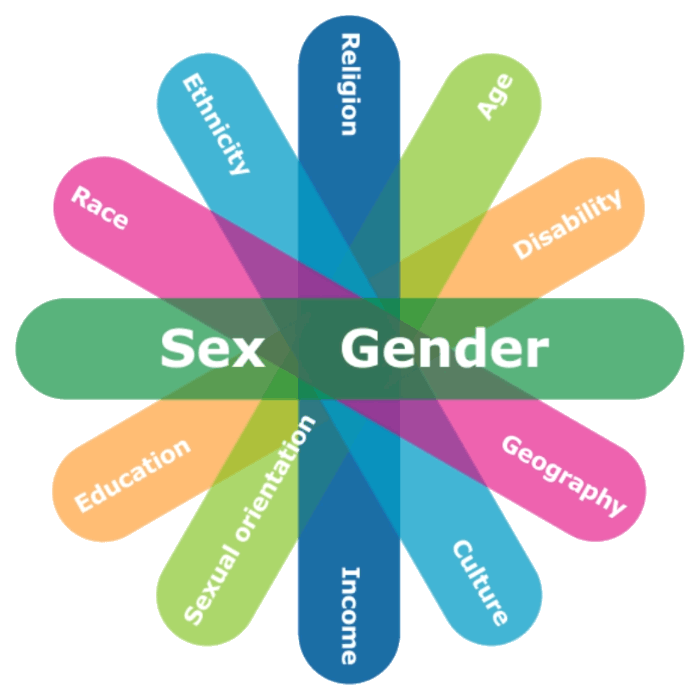
Demographics
While Canadians may share a common set of values, we all come from different backgrounds and experiences. The “plus” in GBA+ acknowledges that GBA goes beyond biological (sex) and socio-cultural (gender) differences to look at the intersecting identities that every individual holds, like race, ethnicity, religion, age and mental or physical disability. This idea of intersectionality was analyzed across budget measures, in terms of direct and indirect benefits that were expected to be seen by various subgroups of women and men.
The chart below shows the number of measures that were identified as carrying notable benefits for specific groups of Canadians (i.e., beyond their representation in the overall population). Since many budget measures carry benefits for more than one group, these numbers overlap across categories. For example, a measure like the National Dementia Strategy will benefit those who are at greater risk of developing dementia. Since early detection and awareness is a key element of the strategy, seniors, women, Indigenous communities and Canadians living in rural areas are most likely to feel the direct benefits from this measure as they have higher risk factors.
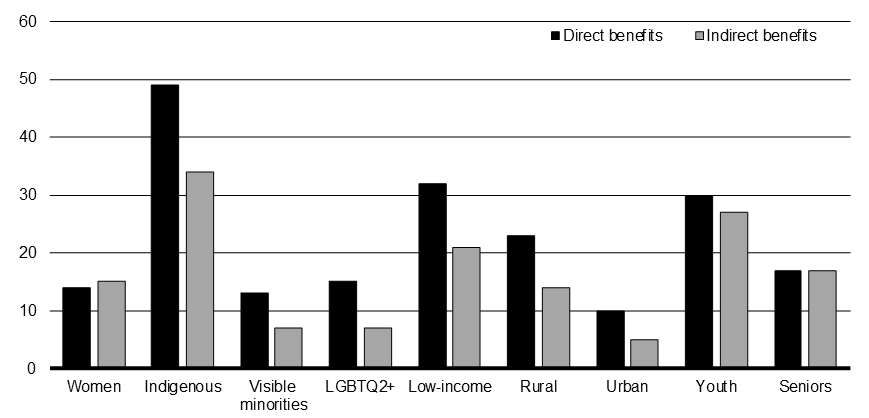
Key Budget 2019 Measures Benefitting Newcomers and Visible Minority Groups
- $45 million over three years for the Multiculturalism Program and to develop and implement a new federal Anti-Racism Strategy.
- $25 million over five years for projects and capital assistance that support Black Canadian communities.
- $35.2 million over five years, and $7.44 million per year ongoing, to make permanent the Global Talent Stream pilot project and ensure that Canadian employers have access to the global talent they need to grow their businesses and create good jobs for Canadians.
- $283.1 million over two years to ensure refugees and other eligible claimants have access to temporary health coverage under the Interim Federal Health Program.
Visible Minority Communities
Visible minorities represent a growing share of the population who continue to be an important driver of Canada’s social fabric and economy. Whether they are asylum seekers, immigrants or Canadian-born, the systemic barriers and challenges faced by visible minorities are as diverse as their backgrounds.
It is estimated that men from visible minority groups are 24 per cent more likely to be unemployed than men from non-racialized groups. Visible minority women are 48 per cent more likely to be unemployed than, and earn 55.6 per cent of the income of non-visible minority men. With respect to social participation, approximately 1 in 5 visible minority respondents to the 2014 General Social Survey reported feeling discrimination or unfair treatment in the five years preceding the survey. Sixty-three per cent of these respondents believed it was based on their race or skin colour.
The need for federal actions aimed at addressing systemic barriers faced by visible minority communities, along with the need for better and more disaggregated data on these issues, stems from a number of key recommendations over the last few years, notably by the Standing Committee on Canadian Heritage and the United Nations Committee on the Elimination of Racial Discrimination. Budget 2018 provided $6.5 million over five years, starting in 2018–19, to create a new Centre for Gender, Diversity and Inclusion Statistics which, among other things, will collect, analyze and disseminate data on visible minorities to understand the barriers different groups face and how best to support them.
15 measures in Budget 2019 were identified as benefitting visible minority communities including initiatives such as the new Anti-Racism Strategy, as well as the Global Talent Stream, Multiculturalism and Interim Federal Health programs.
Rural Communities
Rural and remote communities are essential to Canada’s economic success and social landscape, but face a unique set of challenges, such as lack of connectivity, lack of employment diversity, population decline, out-migration of youth, lower availability and quality of services (e.g., health care), declining infrastructure and lower educational attainment. Budget 2019 has more than 20 measures that provide direct benefits to rural and remote populations including the initiatives supporting the new Arctic and Northern Policy Framework, the creation of a Canadian Experiences Fund supporting Canada’s tourism sector, new investments in the Connect to Innovate program and introduction of the Government’s new the Universal Broadband Fund.
Income Distributional Impacts
Each measure in Budget 2019 was also evaluated with respect to how it affected Canadians at different income levels. Budget 2019 proposes a number of measures with progressive impacts (benefitting lower-income Canadians), such as lowering the interest rate on Canada Student Loans and proactively enrolling seniors age 70 and over for the Canada Pension Plan (CPP) but who have not yet applied. Other initiatives have characteristics that make them more likely to be utilized by higher-income Canadians, such as changes to the Home Buyers’ Plan.
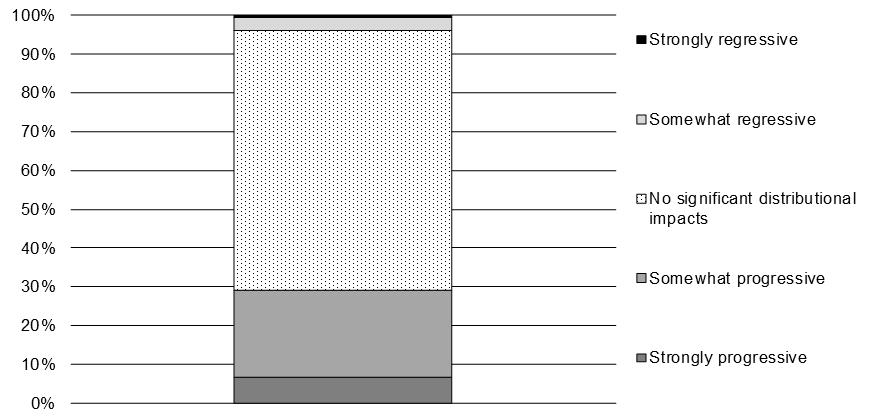
Intergenerational Impacts
In conducting the GBA+, broad consideration was given to how a measure may affect different generations of Canadians. In large numbers of cases, measures impacted generations equally; however, certain Budget 2019 measures primarily provided disproportionate benefits to seniors or to youth. Proactive CPP enrollment will help seniors, enhancing the Guaranteed Income Supplement earnings exemption will tend to benefit low-income working baby boomers, and those at risk of developing dementia will be helped through the National Dementia Strategy. A significant number of measures will also help today’s young people and future generations. For example, the lower interest rates on Canada Student Loans will make post-secondary education more affordable for youth and help them transition successfully to the labour market after their studies. Through the Student Work Placement Program, post-secondary education students across Canada, including vulnerable students and those from underrepresented groups will have access to more on-the-job learning opportunities, following their career aspirations. Children and future generations will also benefit from measures intended to fight climate change, such as investments in clean technologies, carbon pollution pricing and zero-emission vehicles.
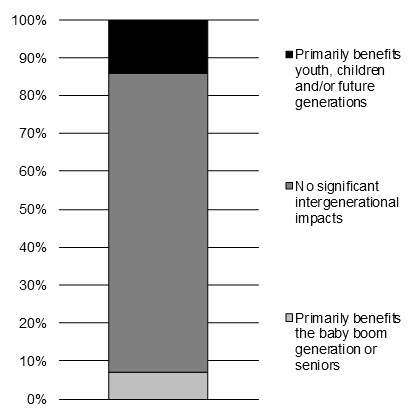
- Date modified: